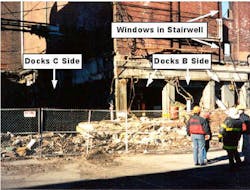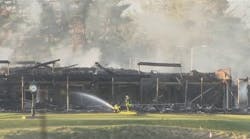Two major investigative reports were compiled following the Worcester Cold Storage Warehouse Fire that claimed the lives of six firefighters on Dec. 3, 1999, giving insight into what happened on that tragic day.The U.S. Fire Administration produced an extensive technical report, and NIOSH investigators also examined the incident.
Both cited interior building construction as a major contributing factor in the tragic blaze. Communications also were a problem, they noted.
The USFA noted that according to NFPA records, it was the first time that six firefighters were killed inside a building where neither a collapse nor explosion occurred.
USFA officials contacted Worcester fire officials asking their cooperation as they examined the incident.
"There were valuable lessons to be learned. We understood it would be challenging and trying for them. They were very receptive to share," said Kenneth Kuntz, USFA fire studies specialist.
One thing emerged quickly as investigators started looking at the incident -- the toll could have been much higher.
"The decision not to send any more firefighters into that building to search was the most difficult one the chief ever had to make. But, it was the right one," he said. "Who knows how many lives he saved by that call."
Crews were faced with a number of challenges from the onset.
The USFA investigators noted: "During its use, various petroleum based insulation materials were incorporated into the building including rigid expanded polystyrene boards and blown on polyurethane foam. These were applied to improve the temperature performance of the buildings. Additionally, condensation along the exterior walls lead to the decay of some floor joists. Steel beams or angle brackets were added against the brick walls to pick up the floor load in several places.
"Even to long term employees, the building was hard to navigate. The upper four stories were almost identical, and some workers reported getting lost under the dim interior lighting conditions. Condensation would cause ice to form around the ceiling fixtures, and this cone of ice would severely limit the amount of illumination. There was no useful external light then or during the fire."
After interviewing firefighters, the USFA investigators determined that two serious situations emerged at the same time -- deteriorating conditions in A-building's second floor and two lost firefighters.
"They competed for radio time, and finally Rescue 1/Portable 5 desperately broadcasted: 'Fire Alarm we have a second emergency here. Get people up on this floor now or we are going to die! We have no air, and we cannot breathe...' "
Although multiple story searches had begun, the Rescue 1 firefighters were too deep in the building to be heard or found in time, according to the USFA report.
NIOSH also detailed the building construction as well as challenges faced by the Worcester crews inside the maze-like structure with few windows.
The document also includes frantic calls for assistance from lost firefighters who are out of air and sharing bottles.
Find the USFA report here (PDF) and the NIOSH report here (PDF).






